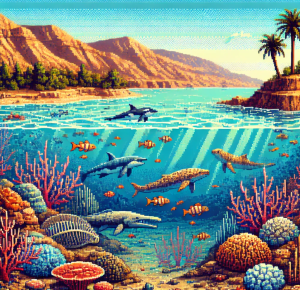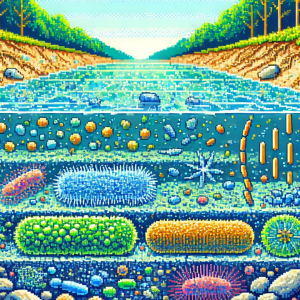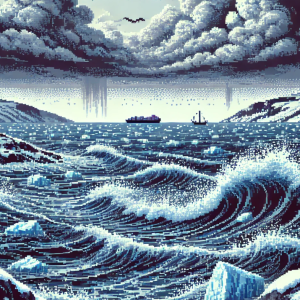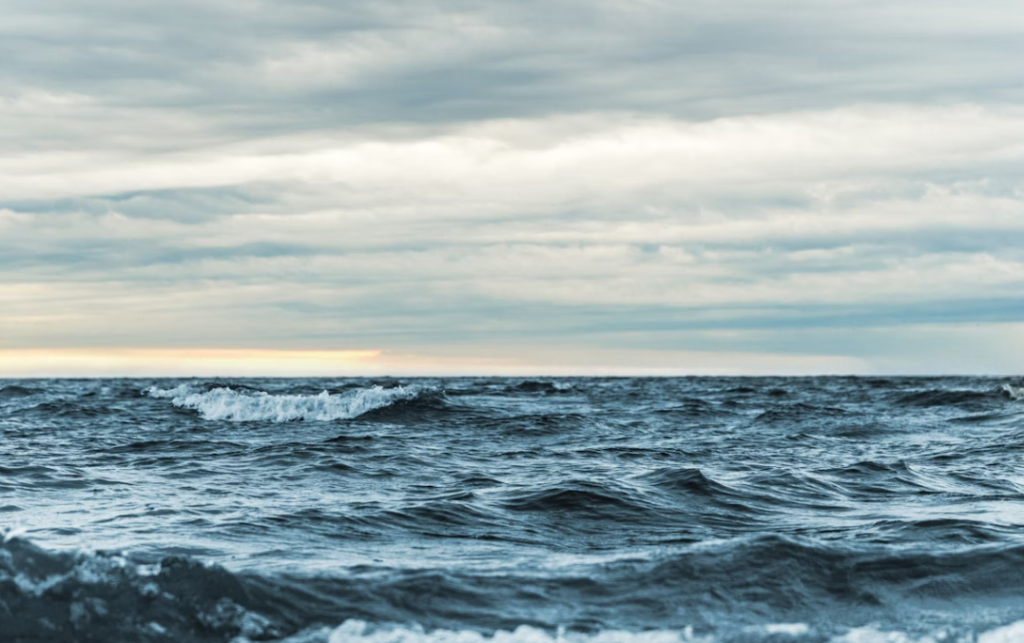
Freshwater vs Saltwater: A Tale of Two Waters
I just spent a week at the beach staring at the ocean and really starting to think: Why is a sip from the ocean a terrible idea, while lake water (if clean) is okay?
In this post, we’ll dive (pun intended) into what sets freshwater and saltwater apart, why the Earth has both types, how they nurture distinct ecosystems, some cool creatures adapted to each world, and why keeping these water worlds in balance is vital, especially as humans impact both.
What Makes Freshwater and Saltwater Different?
The biggest difference boils down to salinity — basically, how “seasoned” the water is with dissolved minerals (salts). Freshwater is, as the name suggests, relatively fresh or low in salt. It typically contains less than about 0.5 parts per thousand of dissolved salts (that’s less than half a gram of salt per liter). Saltwater, like ocean water, contains on average around 35 parts per thousand of salts, roughly 35 grams of salt per liter.
In other words, the ocean is about 220 times saltier than typical freshwater!
To put that in perspective: if you evaporated a cubic foot of seawater, you’d get about 2.2 pounds (~1 kg) of salt left behind, whereas a cubic foot of Great Lakes freshwater would leave only around 0.01 pounds (~5 grams) of salt That’s why ocean water tastes extremely salty, while fresh waters (like rivers and lakes) taste, well, fresh.
The extra salt in seawater not only changes its taste but also alters its behavior. Saltwater is denser than freshwater (which is why it’s easier to float in the ocean — you might have heard about the Dead Sea, so salty that people bob like corks on it). Saltwater also has a lower freezing point than freshwater, meaning it must get a bit colder to freeze.
And importantly for us, you cannot drink saltwater to quench thirst. It’s so salty that it actually dehydrates you — as the old mariner’s saying goes, “Water, water, everywhere, nor any drop to drink”. Your kidneys can only handle a certain amount of salt; any more, and your body must expel water to eliminate the excess salt, leaving you thirstier than before. Freshwater, on the other hand, is what we and almost all land animals rely on for hydration.
Chemically, the salt in saltwater is mostly the same stuff in your kitchen salt shaker: sodium and chloride ions (Na⁺ and Cl⁻). Seawater also contains trace minerals such as magnesium, sulfate, calcium, and potassium. Freshwater contains far fewer ions; it’s often rainwater that has traveled over land, picking up just a tiny bit of minerals. Think of freshwater as the distilled water of nature — relatively pure H₂O with a pinch of minerals — whereas saltwater is like a mineral-rich soup that has been steeping in Earth’s ingredients over eons.
Why Does Earth Have Both Fresh and Salty Water?
Earth is often referred to as the “blue planet” because approximately 70% of its surface is covered by oceans. Those oceans are salty for a good reason. It all comes down to the water cycle and some geological seasoning over time. Here’s the story in a seashell:
In the early days of Earth’s history, when the planet finally cooled enough, rain fell on barren rock and formed the first oceans. In fact, scientists believe those first oceans were filled with fresh water from all that rainfall.
So where did the salt come from? As water flowed over rocks and soil on land, it dissolved minerals (like sodium, calcium, and potassium) and carried them down rivers to the lowest point: the oceans.
When the sun evaporates ocean water (turning it into vapor to form clouds), the salts get left behind. It’s like nature’s giant distillery: water rises, salt remains in place. That vapor eventually falls as precipitation (rain or snow), which is fresh, and replenishes lakes, rivers, and groundwater on land. Those freshwater streams then run through soils and rocks, picking up a bit more mineral seasoning, and again carry traces of salt out to sea. Over millions of years, this process made the oceans salty while keeping rain, rivers, and lakes fresh.
Think of it this way: the water cycle is Earth’s Brita filter. It continuously purifies water via evaporation and rain, giving us fresh drinking water on land, while the leftover salt accumulates in the ocean. This is why Earth naturally maintains two different types of water. Geological factors play a role too: some bodies of water on land become salty if they have no outlet.
For example, lakes like the Dead Sea or Utah’s Great Salt Lake are landlocked; rivers bring in water and minerals, but the water only leaves by evaporation, so salt builds up over time (making these lakes far saltier than even the ocean). But most lakes and rivers eventually flow out to seas, delivering their mineral cargo to the oceans.

So, in summary, we have salty seas and fresh waters thanks to the planet’s plumbing system. Oceans gather the runoff of billions of years of eroding rocks (saltiness is like the “tea” brewed from Earth’s crust), and the atmosphere returns water to land as fresh rain. This delicate balance ensures we have both vast salty habitats and pockets of precious freshwater.
Two Different Worlds: Freshwater vs. Marine Ecosystems
With their contrasting chemistry, freshwater and saltwater create very different worlds for life. If you shrink down and explore a drop of pond water versus a drop of seawater, you’d see distinct communities of microscopic life. Zoom out to entire lakes versus oceans, and the differences are even more dramatic.
Freshwater ecosystems include rivers, lakes, streams, and wetlands. They cover less than 3% of Earth’s surface (in fact, freshwater habitats are only about 2% of the surface) but don’t let their small size fool you. These are rich, vibrant pockets of life. Freshwaters tend to be separated like isolated islands — one lake is not directly connected to another far away, and each river system is its own world. This fragmentation allows species to evolve in isolation, resulting in high diversity per area.
Amazingly, about 11% of all animal species live in freshwater habitats, nearly as many as the 12% of species that live in the much larger oceans. (Land, by comparison, hosts roughly 77% of animal species.) In other words, pound for pound (or drop for drop), freshwater is teeming with species – from tiny insects and colorful fish to amphibians like frogs and giant river salamanders – all specially adapted to life with little salt.

Saltwater (marine) ecosystems encompass the global oceans, along with smaller seas, coral reefs, mangrove swamps, and estuaries where fresh and saltwater mix. Covering 70% of the planet, the ocean is like a contiguous universe for life, with fewer physical barriers than freshwaters. This means big migratory species can roam vast distances, and the scale of life can be extreme, from microscopic plankton to the blue whale (the largest animal ever). Marine biodiversity is incredibly high, especially in complex habitats like coral reefs (often called the “rainforests of the sea” for their diversity).
However, because the ocean is one huge connected body, the total number of species in the sea is spread out – slightly fewer species overall live in the ocean than on land, and roughly equal to that tiny 2% of surface that is freshwater Still, life in the sea has amazing variety: filter-feeding sponges and corals, schools of fish in every shape imaginable, crustaceans, squid and octopus, marine mammals like dolphins and whales, seabirds that skim the waves, and so on. Marine ecosystems also include the deep sea – a world of darkness, high pressure, and strange creatures, which has no counterpart in shallow fresh waters.
One fascinating place is where these worlds meet: estuaries and brackish waters, where rivers flow into the sea. Here, a mix of fresh and saltwater creates a gradient of salinity. Life in estuaries must adapt to changing salinity with the tides – think of mangrove trees with salt-filtering roots, or oysters that can thrive in both saltier and fresher water. Estuaries are often incredibly productive nurseries for fish and shrimp, precisely because they offer a mix of conditions (and fewer ocean predators venturing into the shallows). They’re a reminder that fresh and salt aren’t strictly separated; they continuously interact.
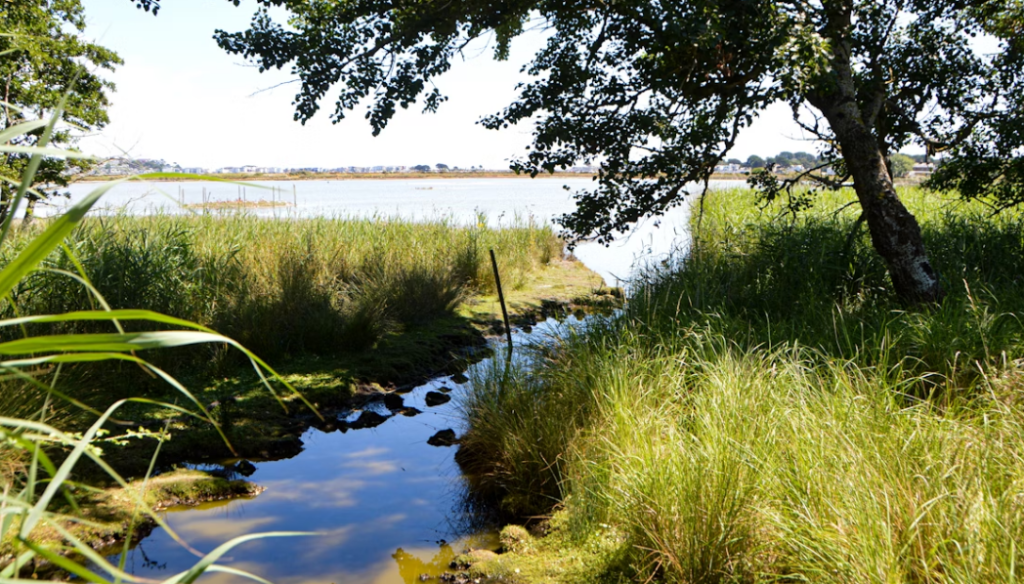
Built for Each Environment: Organisms and Adaptations
Life has adapted to thrive in either fresh or salt water, and some amazing creatures have evolved special tricks for their chosen realm. If you plop a typical freshwater fish into the ocean, or vice versa, it would be in serious trouble. Why? It comes down to osmosis (water moving in or out of cells due to salt differences). Freshwater fish are saltier than the water they live in, so water is constantly trying to flood into their bodies (imagine being a fish in freshwater — it’s like sitting in a bathtub that wants to dilute you!). To cope, freshwater fish do not drink much water and pee a lot – they produce copious dilute urine to expel excess water.
At the same time, they have special cells in their gills that actively take in salts from the water to replace what they lose. In contrast, saltwater fish are less salty than their surrounding ocean, so they tend to lose water (it’s like being surrounded by an even saltier soup that sucks water out of you). To survive, marine fish drink seawater and then expel the extra salt through their gills and kidneys. Essentially, freshwater fish must retain salt and eliminate water, whereas saltwater fish must eliminate salt and retain water. Each type is a product of millions of years of evolution in its environment.
As a result, most fish (and other aquatic animals) are stenohaline, meaning they can only tolerate a narrow range of salinity. A goldfish would quickly die in the ocean, and a clownfish from the reef wouldn’t last in a lake. However, some amazing euryhaline species can handle both. Salmon are a famous example: born in freshwater streams, they migrate out to the ocean to grow, then heroically swim back upstream to freshwater to spawn. Salmon and other migratory fish like eels and shad have the unique ability to switch their osmoregulation strategy as they move; they often transition gradually through brackish estuaries to avoid salt shock Their bodies will re-tool: in the ocean, salmon drink water and pump out salt; back in the river, they stop drinking and start producing lots of urine to shed water. Nature essentially provided them with dual operating systems for salt and freshwater — pretty cool!
It’s not just fish with special tricks. Plants and other animals show neat adaptations too. In freshwater, you find frogs and salamanders (amphibians) that usually must lay eggs in fresh water because their jelly-like eggs would dry out or absorb too much salt in the ocean. Many freshwater turtles, beavers, hippos, dragonfly larvae, and numerous insects thrive in or around lakes and streams, but would struggle in saltwater environments.
Meanwhile, the ocean is home to animals that you won’t find in fresh water, like corals (which need salty water to maintain their calcium carbonate structures) and giant cephalopods like octopus and squid (no freshwater squids lurking in your local pond!).
Marine reptiles, such as sea turtles or marine iguanas, have salt glands that allow them to excrete excess salt they ingest. Seabirds (like albatrosses and gulls) also have special salt glands in their heads to excrete salt, allowing them to drink seawater if needed. And marine mammals such as whales and dolphins get their fresh water from the food they eat; their kidneys are super efficient at conserving water and excreting salt, essentially acting as internal desalination units.

A fun fact: The salt content of most vertebrate blood is about 0.9% (9 grams per liter), which is thought to be a relic of ancient seawater. (It’s no coincidence this is similar to the salinity of our tears or sweat!) This is far saltier than fresh water, but only about one-quarter the salinity of modern ocean water. Some scientists think our distant fishy ancestors evolved when the ocean was less salty than today, and as life later ventured onto land, creatures carried a bit of the sea inside them (in their blood). So, whether you’re a fish or a person, in a way, we all have a little “marine aquarium” running in our veins.
Why Both Water Types Matter (Maintaining the Balance)
Freshwater and saltwater aren’t just habitats for different creatures — together, they keep the planet livable. Maintaining balance in both systems is crucial for environmental health and for us humans.
Consider freshwater first: Only about 3% of Earth’s water is fresh, and the vast majority of that is locked up in glaciers or underground. In fact, less than 1% of all water on Earth is accessible freshwater in lakes, rivers, and shallow aquifers This tiny fraction supports all of human civilization, agriculture, and terrestrial ecosystems. Freshwater is the lifeblood of forests and prairies, and it’s the stuff we drink every day. If you had a gallon jug representing all water on Earth, only a few drops of it would be the freshwater accessible to us – it’s that precious. Keeping those drops clean and available is critically important. Suppose freshwater ecosystems (like rivers and wetlands) are degraded. In that case, it’s not just fish or frogs that suffer — we lose drinking water supplies, crop irrigation sources, and natural filtration systems (wetlands, for example, filter pollutants and buffer against floods).
Saltwater, on the other hand, might not be directly drinkable, but it plays an enormous role in sustaining life on Earth as a whole. The oceans regulate our climate, absorbing heat and redistributing it around the globe via currents. They are also a major oxygen factory. Tiny marine plants (phytoplankton) floating in the sunlit surface of the ocean produce roughly half of the Earth’s oxygen. Yes, every other breath you take, thank the sea! These plankton, along with seaweed and coastal mangroves, are also huge carbon sponges, sucking up CO₂ and helping buffer climate change.
Marine food webs support a rich diversity of life, and many land animals (including humans) rely on the ocean’s bounty. Seafood is a primary protein source for over 3 billion people worldwide. From the fisheries that sustain communities, to the coral reefs that protect coasts from storms, to the sheer wonder of marine biodiversity that inspires us, the salty half of Earth’s water is indispensable.
Crucially, freshwater and saltwater systems are connected. Rivers carry nutrients (and, unfortunately, pollutants) to the sea, while ocean influences, such as evaporation and rainfall, determine where freshwater flows. Many animals even link the two realms, such as salmon (as we saw) or birds that feed in the ocean and nest by inland waters. So a disturbance in one can ripple to the other. Maintaining balance means keeping both fresh and marine environments healthy and functioning as they should.
Troubled Waters: How Human Activity Affects Both Systems
Humans have a tendency to disrupt the balance of things, and water systems are no exception. Our activities have major impacts on both freshwater and saltwater environments — some visible, others more insidious.
Starting with freshwater, consider how we utilize water every day. We divert rivers, dam streams, pump groundwater, and drain wetlands for agriculture, cities, and industry. Overuse and mismanagement can literally dry up rivers (for example, some years the Colorado River in the U.S. barely reaches the sea). Dams generate power and provide irrigation, but they also fragment rivers, blocking fish migrations (imagine being a salmon and hitting a dead-end dam wall) and altering the natural flow that downstream ecosystems expect.
We also tend to treat rivers and lakes as dumping grounds. Pollution is a huge problem: fertilizers and pesticides run off farms into streams, sewage and industrial waste find their way into rivers. This can lead to toxic algal blooms in lakes and reservoirs or contamination of drinking water supplies. One dramatic effect is eutrophication, where excess nutrients (like nitrogen from fertilizers) cause algae to grow like crazy in a pond or lake. When the algae die, they decompose and suck oxygen out of the water, sometimes causing fish kills. Even groundwater isn’t safe; pollutants can seep down and remain hidden for years.
Our impacts flow downstream too. All those nutrients and pollutants the rivers carry end up in the oceans. Coastal waters near big river outlets often suffer from “dead zones.” For instance, the Gulf of Mexico at the mouth of the Mississippi River develops a huge low-oxygen dead zone each summer due to fertilizer runoff from thousands of farms upstream. Essentially, the process is similar to a choked lake: nutrient overload -> algal bloom -> oxygen crash. In these dead zones, oxygen gets so low that most marine life flees or suffocates. It’s a stark example of how human activity on land can harm ocean ecosystems far away.
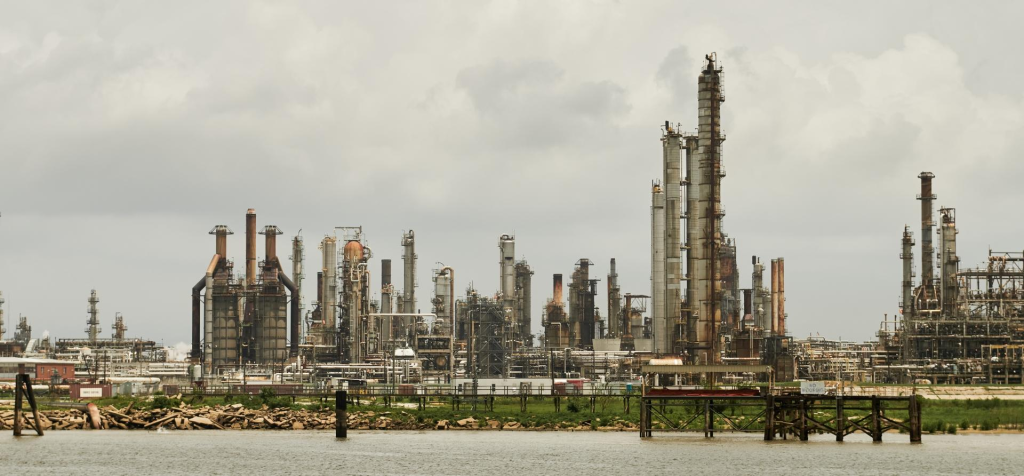
Beyond pollution, overfishing has heavily affected saltwater systems. We’ve become too good at catching fish; many wild fish stocks have plummeted. Removing top predators like certain sharks, or herbivores like parrotfish in reefs, can throw the whole food web out of whack.
Meanwhile, climate change is a looming threat over both fresh and salt water. A warming climate can intensify droughts and alter rainfall patterns, drying up freshwater sources or causing more extreme flood.. For the oceans, warming water stresses coral reefs (leading to coral bleaching) and shifts where species can live. Perhaps even more alarming, the oceans are absorbing a lot of our excess CO₂, which makes the water more acidic over time (ocean acidification). This acidification eats away at coral skeletons and shellfish shells, imperiling those organisms.
There’s also plastic pollution – those images of sea turtles tangled in plastic bags or dolphins playing with plastic rings are heartbreaking. Millions of tons of plastic waste end up in the oceans each year, breaking into microplastics that even plankton and fish ingest. And in freshwater, plastic and trash accumulate in rivers and along shores as well. Oil spills, chemical spills, heavy metals from mining, you name it – both rivers and oceans have seen their share of human-made messes.
All these impacts highlight why it’s so important for us to protect and restore water ecosystems. The good news is that awareness is rising. Efforts are underway worldwide to reduce pollution (think better farming practices, wastewater treatment, plastic reduction initiatives) and to establish protected areas in both freshwater and marine environments. Many countries work to manage fisheries sustainably now, and conservationists strive to restore wetlands and free-flowing rivers. On an individual level, we can help by using water wisely, minimizing use of harsh chemicals that run off into drains, supporting policies that protect water quality, and even simple actions like picking up litter before it reaches a stream or beach.
Conclusion
Freshwater and saltwater each have their own character — one is essentially life’s drink, scarce and precious, and the other is life’s cradle, vast and vibrant but undrinkable. Through a mix of geological processes and the grand water cycle, Earth keeps these two water types circulating and interacting in harmony: rivers and rain constantly refresh the lands, while oceans collect and recycle the planet’s mineral wealth. This dynamic has given rise to two different but interconnected worlds of life. From the minnow in a creek to the great white shark in the sea, from water lilies to kelp forests, nature has crafted elegant solutions to living in fresh vs. salty conditions.
We’ve seen that the difference between freshwater and saltwater is more than just salt. It’s a story of planetary cycles, evolution, and balance. And it’s a story in which we humans have a big stake. Our bodies need fresh water every day, and our planet’s climate and oxygen supply quietly depend on the oceans. We need thriving fish in both the lake and the sea for food and ecological balance, and both ducks on the pond and seagulls on the shore to remind us of the beauty and diversity of life.
So the next time you’re sipping water or swimming in the ocean, take a moment to appreciate these two fantastic flavors of H₂O. The combination of fresh and salty elements makes Earth the vibrant blue world we call home. And like any good tale of two siblings, both deserve our respect and care to keep the story going strong for future generations. After all, whether it’s a river, a reservoir, or the rolling sea — it’s all water, and it’s all connected. Let’s keep it clean and flowing!

